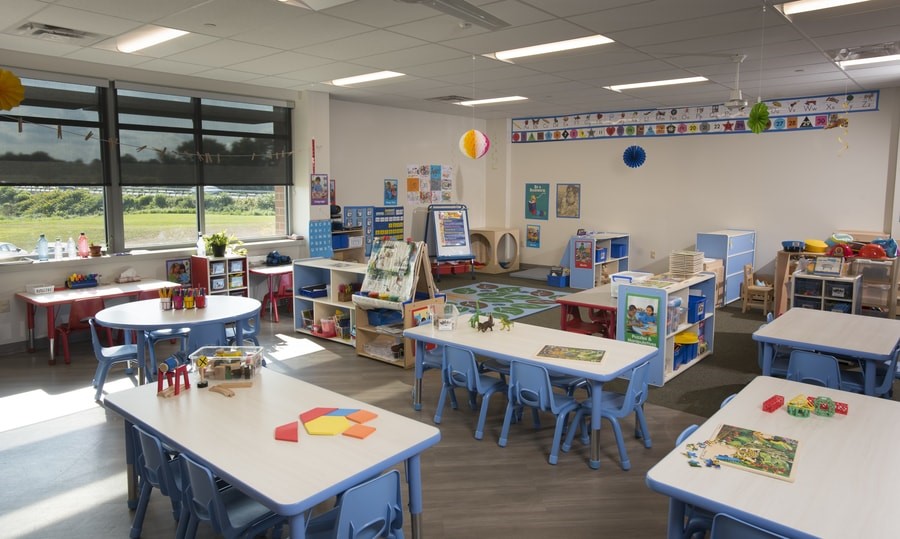- 855.224.8655
- Schedule a Tour

Whether you are an experienced preschool teacher or new to early education, you probably have thought about the best ways to make the most of your preschool classroom layout. You want to be creative with your setup, but you also want to ensure that the items in your classroom promote a positive learning environment.
At U-GRO Learning Centres, our team members’ preschool classrooms focus on four well-defined areas that promote experimentation, interactive play, self-direction, and more.
Learn more about the four key components of a U-GRO preschool classroom and how each area helps set children up for success in kindergarten and in life.
Learning Centers – Play Areas
U-GRO preschoolers love to play in learning centers, which are play and learning areas that are always set up in the classroom and are clearly defined for a particular kind of play. Learning centers include areas like:
- Science table
- Dramatic play
- Block play
- Letter table (featuring the letter of the week)
- Math table
- Writing table
- Fine motor/manipulative area (e.g., puzzles, pegboards, and other materials)
- Art table
Book area
Learning centers encourage cognitive and social-emotional development. These stations provide tremendous opportunities for children to learn through hands-on experiences. They can develop their own interests and spend time at centers they like. With free play, children also learn how to share, self-regulate, and solve conflict.
It is important that learning centers are set up to separate active and low-active learning centers, as well as quiet and loud centers. This improves children’s ability to engage with centers requiring focus and concentration.
Teachers should also try to change and add items to the learning centers that align with weekly themes or seasons. Changing the items also ensures that they remain engaging to students.
Learning Stations
Our learning stations take place daily during a designated time in the daily routine. Learning stations focus on the theme or letter of the week and cover curriculum learning goals in literacy, math, science, technology, etc. Activities for stations are planned for the week and brought out during the set learning stations time.
It is important to introduce the activities to the children so they know what each station has to offer and how to use the materials. While the teacher may conduct a small group lesson during this time, children should move from station to station as they choose and allow for demonstration of independent learning.
At learning centers, children are developing cognitive, fine motor, and social skills, including listening, taking turns, and more. All of these are important as children prepare for the kindergarten classroom.
Print Resources
U-GRO’s curriculum department supplies resources that help to reinforce concepts children are learning in other areas of the classroom, like math and science. For instance, teachers have a designated area for morning meetings, with items like a calendar to practice counting, days of the week, and patterns, as well as a weather chart to reinforce science concepts.
Here are a few examples of print resources located throughout a U-GRO preschool classroom:
- Letters and numbers for recognition
- Calendar and weather charts
- Photos to represent different cultures (e.g., real pictures of students’ families)
- Job charts
Artwork and Decorations
Artwork is a great way to showcase skills that students are learning, including creativity, self-confidence, imagination, etc. At U-GRO, we encourage teachers to designate no more than four set spaces in their classroom to showcase children’s art. Having a few areas focused on art will prevent overstimulation and place focus on the projects being highlighted. Teachers should rotate at least one art area per week to keep it relevant to the theme, learning goals and standards, seasonality, etc.
Importantly, artwork should have a purpose in the classroom. Team members can utilize their space to show curriculum standards students are working on, and how art is supporting student learning and creativity.
Let your students be involved in what goes on the classroom walls. Create a group painting as an opportunity to practice teamwork and communication, and then hang that piece of art on a classroom wall! Children will feel confident and proud to see their work on display. A collaborative piece of art allows every child to leave his or her mark on the classroom.
The right preschool classroom setup should reinforce learning, encourage imagination, and promote socialization. We utilize free play learning centers, learning stations, print resources, and artwork in our preschool classrooms to create a positive learning environment for our students.
